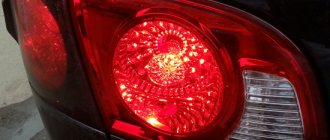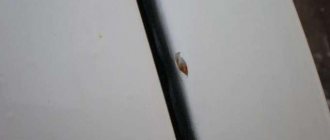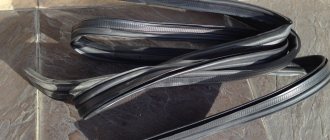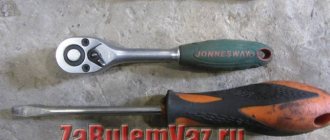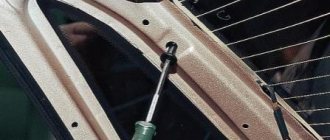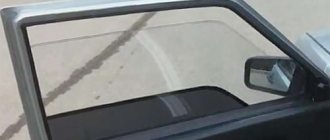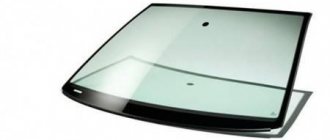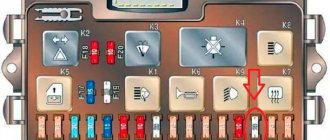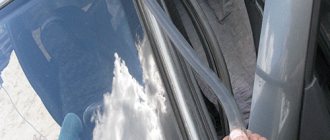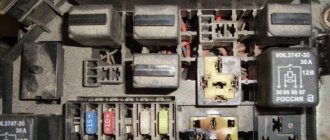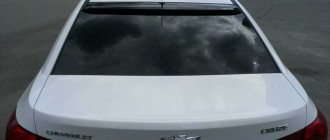Car tinting is one of the most popular car service services. However, over time, the need arises to remove the tinting material due to its wear and tear, improper operation, adverse environmental effects, tightening of administrative sanctions for tinting, change of vehicle owner and other factors. Cleaning the glass from the film completely is not an easy task, since in most cases sticky adhesive stains remain on the surface, interfering with the normal operation of the car and worsening its appearance.
Recommendations
Tips for quickly and effectively removing traces of glue from tinting:
- You need to start cleaning immediately after removing the tint.
- The longer the tint was on the glass, the stronger the glue will adhere to it. For difficult cases, choose products with an aggressive composition.
- When working with any solvents, you need to take care of personal protective equipment in the form of gloves and a mask.
- After finishing cleaning, the glass must be washed and wiped dry. This will allow you to identify untreated areas and, if necessary, repeat the procedure.
When choosing a glue remover, you should always pay attention to its composition and the manufacturer’s recommendations. There are substances that cannot be used on glass surfaces.
You will find a lot of useful information about ways to remove glue from glass in this section.
Safety precautions
Most chemicals and folk remedies are toxic and have a pungent odor that lasts for a long time. They can cause burns to the mucous surfaces of the respiratory system. Contact with skin leads to the formation of wounds, so you need to work with them carefully.
Do not smoke while working and generally do not clean near an open fire or near hot objects. Concentrated vapors may cause fire.
Before carrying out work, you should take care to follow safety precautions and prepare safety glasses that will save your eyes from contact with chemicals. A respirator, or in extreme cases a gauze bandage, will protect the respiratory system. Rubber gloves will protect your hands from chemical burns.
Sometimes you have to tint windows on loggias and in apartments - glue a shading film on them. If you are tired of the darkening or the film needs to be replaced, you can do this in the same way as in a car: first remove the film, then wash off the remaining adhesive base.
Pharmacy products
Alcohol-based products can be used as an inexpensive alternative to specialty cleaners.
The most effective way to remove tint adhesive is:
- ammonia;
- formic alcohol.
A small bottle costs 7–50 rubles. It is enough to clean 1-2 glasses.
Ammonia is a little more expensive, but more effective. Please note that it has a strong unpleasant odor. You must use it to wipe off glue from glass in the fresh air, otherwise there is a risk of poisoning from the fumes.
Formic alcohol takes longer to dissolve glue, but it is cheaper and not harmful to the respiratory system.
How to remove glue residue from glass:
- Prepare cotton pads (viscose napkins, rags), ammonia or formic alcohol.
- If the glue is relatively soft, soak a cotton pad in alcohol and immediately wipe the glass.
- If the adhesive composition has hardened, apply ammonia (formic) alcohol to the glass and leave for 5-10 minutes. For convenience, you can pour the liquid into a container with a spray bottle and spray. At the end of the specified time, the glue will become soft, you can wipe it off with a cotton pad or rag.
In the end, all that remains is to wash the glass from stains. Use soapy water or any glass cleaner.
Composition of tinting adhesive
After removing the tint, sticky spots remain - part of the adhesive coating used in production. Tinting is a special self-adhesive film. The bottom layer contains special adhesive compounds that, when in contact with the surface, form a strong adhesion.
The stronger the adhesive coating, the stronger the film will adhere. This means that you will have to clean the glue off the glass after tinting.
Various adhesives are used in the production of tinting: CD, PS, CDF, DPS, PS/DT. Considering so many of them, it is quite difficult to answer the question of how to remove glue from glass after tinting. Each case is individual and requires the use of different removal methods.
How to remove tinting so there are no marks left on the glass
After removing the tint film, traces of glue remain on the glass
A sure-fire way to clean glass without leaving glue residue is by heating it. The coating is heated to 40-60 °C using a hair dryer, and the film along with the adhesive base is removed without problems.
But there are several reasons why this method may not work:
- no hair dryer;
- there is a high probability of damaging the plastic upholstery;
- the film is already torn into shreds.
To remove the tint coating yourself without heating, you need to pry the top edge with a knife so that you can grab it with your fingers. This must be done with both hands at the same time, while pulling down forcefully. There will be little glue left on the surface, it will not be difficult to wash it off.
We recommend: How to straighten stray down in a washed down jacket
If you have time, it is best to remove the tint using a soap solution, pouring it over the separation area. In this case, the glue will still remain on the glass and will have to be cleaned. This method is especially good when working with the side windows of a car. It will help prevent the window regulators from breaking.
Characteristics of tint film
The tinting material is made from a thin layer of polyester. There are several such layers on the film. And its ability to transmit light depends on their number.
When installing the material, the film is glued to the glass using the adhesive composition on it. The gluing process is quite simple:
- the surface is degreased;
- then a soap solution is applied and a film cut to size is glued on.
The glue hardens on the glass and the film adheres to the surface.
How various gadgets are attached to the windshield
Well-known manufacturers of specialized automotive devices have recently tried to avoid using adhesives for attaching devices to the windshield. Instead, they prefer suction cups, which securely hold devices in place without leaving marks.
But if the device was not originally intended for a car, or its manufacturer decided to use an adhesive when attaching it to reduce the cost of production, problems will arise after removing such a gadget.
The adhesive composition can be single-sided or double-sided. In the first case, a small adhesive layer will remain on the glass after peeling off; in the second option, a rubberized element may remain along with it.
How can I remove tinting glue from glass?
The tint material leaves marks that are quite difficult to remove if the film is removed incorrectly. However, this problem can be dealt with using both professional chemical compounds and home remedies. It is important to observe safety precautions, follow the instructions for use and handle the glass carefully.
How to remove tint material without sticky streaks
You can wipe off the glue from the tint with anything - there is a wide choice of professional and folk remedies, but the success of the manipulations directly depends on the actions taken to remove the film. The more carefully the tint layer is removed, the less adhesive composition will be observed on the plane. Tint removal options:
- One sharp movement. You should pick up the edge of the covering, grab it with both hands and pull it down with a sharp movement. Sticky particles will remain on the surface.
- Slow removal. To soften the glue, it is necessary to heat the tinted surface using a hairdryer to a temperature not exceeding 60 °C. Then you need to pry off the tint material with a knife or other sharp object and gradually remove the film, periodically heating the places where it comes into contact with the glass. After using this method, very few adhesive particles will remain.
- Soapy solution. You should mix a little liquid soap or soap shavings with water until a homogeneous solution is formed, separate the edge of the film with a knife and apply the mixture to the junction of the tinting with the glass. The material must be removed very slowly, otherwise the glue will not move away from the plane.
- Ammonia solution. Ammonia should be applied to the tint, then cover the treated area with cling film. After several hours, the material can be easily removed along with the glue, and the remaining particles of the adhesive composition can be wiped off with a regular soap solution.
Safety precautions when cleaning a car
Useful tips on how not to damage car parts during manipulations:
- the glass should be heated with a hairdryer no more than 40–60 °C, otherwise it will crack, and the film and plastic used to decorate the interior may melt;
- To make it easier to remove the film from the side windows, you need to lower the glass halfway;
- cleaning the rear window should be carried out with extreme caution to prevent damage to the heating filaments;
- working with chemicals (especially highly toxic ones) requires the use of a respirator, gloves and a protective suit;
- Under no circumstances should the vehicle be left with adhesive residues on it, as it collects dust and dirt, interferes with the driver's view and may interfere with the operation of the power windows.
How to remove tinting marks
Before removing glue from glass after tinting, you must choose the right proven product. You should not experiment with your own car and test various techniques, since such carelessness threatens damage to expensive and difficult-to-install elements.
The most popular methods that have shown high efficiency:
- mechanical impact;
- treatment with soap solution;
- use of oil-containing substances (gasoline, acetone);
- applying compounds to remove tinting from car windows.
Special chemicals:
- biosolvents;
- universal household cleaners;
- glue cleaners.
Instructions for removing adhesive using different means
Before removing the adhesive mechanically, you need to prepare a solution based on water, liquid soap or wood shavings. The best effect will be achieved if you add ammonia (3-4 drops) to the mixture. The dried adhesive composition is heated with a hair dryer, soap foam is splashed onto the surface to be cleaned. Then the glue is rubbed off with a special scraper without pressing the device too hard to avoid scratches. If all sticky particles have been removed, it is worth degreasing the glass with alcohol or solvent.
Important! For the mechanical method, instead of a soap solution, glass washing liquid (windshield washer), which should be made from ethyl alcohol, is suitable.
Shavings of laundry soap mixed with water or an aqueous solution of dishwashing detergent can also remove traces of glue on glass. It is necessary to apply the liquid to the surface to be cleaned and wait until it dries, then repeat the procedure again. The adhesive composition can be easily removed with a soft cloth or sponge, after which you should wipe the glass with a dry cloth.
We recommend: How to starch fabric: tips and rules that every housewife should know
Solvents containing petroleum easily remove sticky traces of tinting. It is necessary to wipe the entire surface with the selected product, wait about 10 minutes and easily remove the soft glue with a sponge or cloth.
Important! Solvents are toxic, so you should remember safety precautions when working with such products. It is necessary to ensure that the trim and other elements in the interior and body of the vehicle are not damaged.
Many stores sell special compounds for removing tinting. It is enough to apply them to the surface, wait the time specified in the instructions, remove the adhesive particles and wipe the glass dry. The disadvantage of this method is the high cost of professional compositions.
Other products that have shown high effectiveness:
- the rust converter is applied to the sticky glass for 10–15 minutes, after which the glue can be easily washed off;
- “Anti-Glue Moment”, which recently appeared on the modern market, destroys various types of sticky bases; its convenient gel-like consistency makes it easy to clean vertical surfaces;
- "Citosol" is an absolutely non-toxic biosolvent that copes with vinyl and bitumen in the adhesive material;
- anti-corrosion compounds or water-repellent sprays are used in a similar way to solvents and can easily cope with sticky glue stains on glass;
- liquid for cleaning headlights and body parts from bugs (you shouldn’t skimp on such a product, it’s better to choose a high-quality and effective one).
Sometimes motorists resort to unusual cleaning methods. The most commonly used is Cola Cola. Glass with glue residues should be wiped with a soft cloth or sponge dipped in soda.
Important! When cleaning the surface of glue, you need to first try the simplest and most accessible methods; if that fails, move on to products with a completely different composition and principle of action.
Removing tinting glue from glass is not difficult if you choose the right product. The more aggressive the composition, the less effort will be required to remove sticky marks. However, you need to work with such substances carefully.
The safest and most inexpensive solution is a soap solution , but cleaning glass using it may take longer.
How to tint
You can do your own headlight tinting in two ways:
- cover the surface with film;
- paint the shield with varnish.
When tinting yourself with film, you need to remove the optics from the car. When sprayed with varnish, the headlights remain in place. The elements located nearby are covered with masking tape and covered with newspapers for better protection.
The work site must be dry and windless. A constant positive temperature will ensure a high-quality adhesion of materials and eliminate the occurrence of cloudy spots.
Varnish
Tinting headlights with varnish is a common type of tuning. Black color is used for both front and rear lights.
Before work, preparatory manipulations are required:
- Wash the work surface and associated parts.
- Inspect the surface for chips, scratches, or clouding.
- If necessary, repair chips and polish the shield.
- Degrease the glass.
- Cover adjacent parts with tape.
- Protect the wings, bumper, and hood with covering material or newspapers.
- Degrease the surface again using lint-free wipes.
The headlight varnish is applied in a thin layer, the drying time is indicated on the packaging and is usually 15-20 minutes. The spray is held at a distance of 20 cm and applied evenly to the headlight. To avoid drips, the varnish is sprayed in thin layers without stopping in one place. For a good result you will have to apply 3-4 layers.
When covering with a spray tint, it is important to be careful not to work near an open flame. The respiratory organs are protected using a respirator. The time for complete drying is indicated on the packaging with the composition.
The complete drying time is indicated on the packaging with the composition.
Drivers consider the advantages of varnishing to be the possibility of easy polishing after clouding from sandblasting during operation. The negative side is that it is difficult to remove headlight tinting paint from the surface.
Special means
Special cleaners are available to remove glue. They have dissolving ability, are easy to apply, and do not emit a pungent odor.
List of popular glue cleaners:
- "Super Moment Anticley";
- KERRY tint remover spray;
- Koch Chemie Eulex professional cleaner;
- KUDO spray;
- glue cleaners ZM 08984, 3M 08184.
The latest products, from , have the largest number of positive reviews, smell pleasantly of citrus and quickly remove the adhesive on glass. The only negative is the high price (from 1000 rubles). Other cleaners will cost 150–500 rubles.
Methods for removing adhesive
You can wipe off the adhesive residue in different ways. However, not all of them are safe. The most popular methods for cleaning car glass from glue after removing tinting are:
- Cutting is done using sharp tools. Before work, moisten the glass with soapy water. This method is the most effective, but requires a lot of time and patience, especially if the glass is heated. After cleaning, the surfaces must be wiped with alcohol or another degreaser.
- Wipe the glass with a cloth previously soaked in any solvent. After a few minutes, the glue is cleaned off with a squeegee. When using this method, you must adhere to fire safety rules, and then you need to get rid of the smell in the car interior.
- To clean the glass from glue after tinting, use special liquids in the form of a spray. The substance is applied to the surface and wait for the time indicated on the package. To remove glue from glass tint, use a special spatula, which is sold with the bottle. The disadvantages of such products include high price and toxicity.
- You can remove glue from glass after tinting using a thick soap solution and a sponge. Any dishwashing detergent available in the house is diluted in water until a rich foam forms. Apply the solution to the contaminated surface with a sponge. It is allowed to dry and then applied again. Dried glue can be easily cleaned off with a soft abrasive - the other side of the sponge. The cleaned surface must be wiped dry.
- They use a special rust converter, Star Wax - spray it onto the surface, wait about 10 minutes and wipe it with a rag.
- Profoam 2000, WD-40 or anti-rain cleaner is applied to the glass and then removed with a rag or squeegee, which can be replaced with a plastic card.
- Supermoment Antiglue removes glue from any vertical surfaces.
- Cytosol removes the adhesive layer from bitumen or polymer components.
- Coca-Cola Lemonade copes with many types of glue no worse than expensive special products.
Mechanical method
The first thing that comes to mind when there is glue residue from tinting on the glass is to scrape it off with something sharp. The good thing about the mechanical method is that it works quickly and reliably. However, it is worth considering that micro-scratches often remain on the glass. They may not be visible indoors, but they are clearly visible in the sun.
It is better not to use metal scrapers and blades to clean glass to avoid scratches.
To remove glue from car glass:
- Arm yourself with a plastic scraper or a plastic card.
- Spray the surface with soapy water. To prepare it, fill a bottle with 1 liter of water and add 3-4 drops of dishwashing detergent (liquid soap, shampoo).
- Wait 10 minutes. Apply the solution periodically. It shouldn't dry out. You can place wet rags or sheets of newspaper on the glass.
- Scrape off any softened glue.
How to clean the rear window of a car from glue
It is impossible to clean the heated rear window of a car using a scraper or blade. The heating filaments can be damaged, so it is better to use other methods.
When removing film from the rear window, proceed in the following order:
- Remove all seals from the window. This will provide free access to the edges of the tint film.
- Wet the glass with the prepared solution, paying special attention to the top part of the tint. The solution should penetrate under it.
- Separate the coating from the glass and carefully pull it down with both hands. Wipe off any remaining glue immediately.
Self-removal of coating
Before you start removing the tint, you need to know how to remove it so that as few sticky spots as possible remain on the surface. There is a special way by which you can remove the film as cleanly as possible. Its surface is heated to 50° with a hair dryer and slowly pulled together.
However, rarely does anyone resort to using this technology in practice due to the lack of a hair dryer or fear of damaging the surface.
You can remove tint yourself in the following ways:
- with a quick jerk, during which the entire film is removed;
- heating with slow peeling;
- gradual removal of the coating.
To wash adhesive residues from the glass surface, it is necessary to use the most effective and affordable methods.
If independent intervention does not give the desired result, you should use another glass cleaning product or contact a professional.
How to remove tint adhesive yourself
The most common way to remove glue is scraping with a special scraper.
The film can be glued with different types of glue, so the cleaning methods differ.
The adhesive applied to the film is an adhesive coating. It connects materials of different structures by surface adhesion. It usually contains resins, several types of adhesives, bitumen, vinyl and other components. The service life of the tint coating depends on the quality of the adhesive, so cleaning the glass from adhesive residues is not always easy.
The most common way to remove glue from car windows is by scraping or cutting. This procedure is carried out using a special spatula, scraper or plastic card. If you don't have them, you can use a regular razor blade. In this case, the scraper must be held at an angle of approximately 30-40 °.
The remaining sticky base must first be moistened with a soap solution. To speed up the dissolution process, you need to add a few drops of ammonia to the liquid. During cleaning, you need to be extremely careful not to get hurt or scratch the surface.
Special means
There are many commercially available products for removing adhesive residue from tinting:
- Spray “Kerry” and other special film removers. Thanks to aerosol packaging, they are easy to apply to the surface and effectively dissolve the glue. It is necessary to apply it to the adhesive stain and wait a little. And then clean the surface with a soft spatula. The product is toxic and expensive.
- Super Moment “Anti-glue” is a new drug created specifically for dissolving adhesive stains. Its consistency resembles a gel, it is convenient to use.
- The rust converter “Star Wax” helps to wash off glue and works quickly. Sold in hardware stores. The converter must be applied to the car glass, and then the remaining film must be scraped off and the surface thoroughly wiped.
- Biosolvent “Cytosol”, which dissolves vinyl and bitumen components. Not hazardous to health. Its main disadvantage is that the drug is difficult to find on sale.
- Adhesive cleaners ZM 08184 and ZM 08984 clean well and do not scratch the glass surface. These products are sometimes called “orange” for their unique smell.
- “Profoam 2000” is a universal household cleaner that is used to remove tape and various stickers.
- “Bug Blitz”, “Resin & Bug Remover” and similar liquids used to clean the body and headlights from traces of insects and silicone deposits.
- “Anti-rain Turtle Wax Clear” is a water-repellent product. The active substance is capable of dissolving adhesive stains.
You can try to wipe the glue off the film from the glass with any dishwashing detergent. An aqueous solution with abundant foam is made and the glass is wetted. After drying, it is washed off with a sponge with a soft abrasive, that is, the hard side of a dishwasher. And wipe it dry with a rag.
The best time to remove tint film is in the summer. In winter, you need to work in a warm garage. If this is not possible, you will need to apply abrasive compounds many times until the adhesive base dissolves to the point where it can be cleaned with a sponge. You may need to change medications several times.
Alfa Romeo 156 ❶.❽TS ⋆MauraGreen⋆ › Logbook › Removing tint, removing glue residue
History...The previous owner had the Alpha tinted all around. When it was time to register and undergo maintenance, they announced: either remove it now or pay a fine. Without hesitation, I tinted the front windows on the spot using improvised means (a stationery knife). PS
To be honest, it became more convenient for me, otherwise I constantly had to lower the windows to look in the side mirrors
Result: glue residue all over the glass.
Last night, I decided to remove the remaining glue.
What you will need:
Hands - 2 pcs White spirit (solvent) - 1 pc (about 50 rubles) Dish sponges with a hard side Armed and go!
2 hours of successful work. (2 sponges + half a can of liquid)
From July 1, 2012, for the operation of cars with tinted windows that do not comply with established standards, in addition to a fine of 500 rubles, license plates will be removed. This provision is contained in amendments to the Code of Administrative Offenses (CAO), toughening penalties for traffic violations, which were signed by Russian President Dmitry Medvedev on April 22. The provision on the removal of license plates for illegal tinting has been added to paragraph 1 of part 3 of article 12.5 of the Code of Administrative Offenses, which previously provided for only a fine for such a violation. In this case, the amendments allow the vehicle to be driven to the place where the tinting is removed (for example, to a car service), however, the violation must be eliminated no later than 24 hours from the moment the license plates are removed. After the car owner gets rid of the tint film, the license plates will be returned. At the moment, according to GOST requirements, the light transmission of the windshield must be at least 75 percent, and the front side windows must be at least 70 percent. Amendments to the Code of Administrative Offenses also provide for the removal of license plates in case of operation of a vehicle with a high noise level or that does not comply with environmental standards, as well as for vehicles with a faulty brake or steering system that have not passed state technical inspection, and which have illegally installed sound or light signals. A similar penalty is provided for cars without compulsory motor liability insurance.
Pros (pros):
1. The car interior does not fade in the sun + the interior heats up less; 2. Don't worry about forgotten things in the car. From the outside, due to the tinting, it is not visible what is in the cabin; 3. The sun is not so blinding; 4. No one stares at you in traffic; 5. Asshole auto fixers don’t see who’s in the car and don’t take risks (the 90s are over, but still); 6. Cars behind do not glare into the mirrors with their headlights; 7. In case of an accident, the glass does not crumble, and all the fragments remain on the film, unless, of course, the tinting was done with film; 8. You can make love in the car even during the day)))
Cons (cons):
1. It is inconvenient to park in yards at night, because... I can not see anything. I remember I had to roll down the windows in a snowstorm to back up in a dark yard... Craftsmen build xenon into a reversing headlight, but I haven’t seen this with my own eyes. Therefore, I can’t say anything; 2. At night in the city, the tint turns into a mirror. Several times I stood in traffic and stared at my reflection; 3. If you like to bomb, then you have to be careful. They will put the barrel to their temple and no one will see it; 4. Traffic police officers fine you for tinting (((
How to remove tint yourself.
First, it is advisable to warm up the glass from which you plan to remove the film. In this case, the glue will become softer, and the tint will be much easier to separate from the glass. You can use a regular hairdryer to warm it up. Without bringing it too close to the surface, to avoid overheating, heat the glass evenly before removing the tint yourself. Do not allow plastic trim parts to become hot.
Then you should lower the glass to about halfway if we are talking about the side windows of the car. This will make it much easier to separate the top edge of the film from the glass surface. It is better to separate the edge of the tint with a sharp knife.
Next, there are two ways to remove car window tinting. The first involves removing the tint film in one sharp movement. To do this, you need to grab the top edge of the film with both hands and forcefully pull it down. Following the second method, the tint is removed gradually. With one hand you need to slowly pull the film towards you, and with the other, carefully separate the glue from the glass using a sharp thin knife or blade.
But in both the first and second cases, traces of glue will most likely remain on the glass. So before you remove the tint yourself, prepare everything you need to then completely clean the glass from traces of glue. A sharp stationery knife can help you with this; you can use it to scrape off any remaining glue from the glass. But the knife may leave scratches on the glass, so it is better to use special solvents designed for cleaning glass after tinting. They can be purchased at any auto store. Undiluted medical alcohol is suitable for the same purposes.
If there is little glue left on the glass, it can be removed using ordinary dishwashing detergent (I tried it, but it didn’t work for me)))), diluted in warm water. It is necessary to moisten the glass with this solution and wipe thoroughly with a soft cloth.
By removing the tint yourself, you will save about 1,000 rubles. This is exactly how much this service costs in auto repair shops. But in order to tint the heated rear window, it is better to contact specialists. Even if you know how to remove the tint yourself, you can damage the heating filaments of the glass and, accordingly, damage it.
